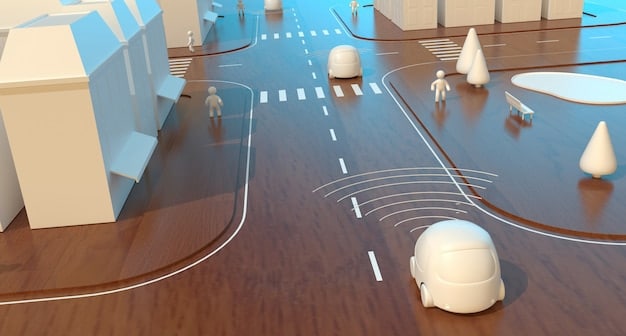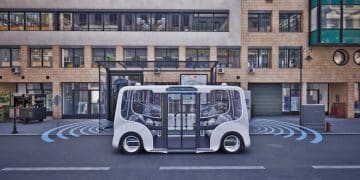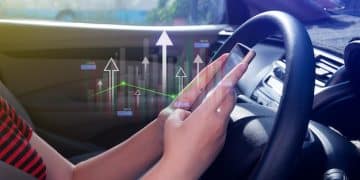LiDAR vs Radar: Which Tech Will Win the Self-Driving Race by 2026?

LiDAR and radar are both crucial sensor technologies for self-driving cars, but while LiDAR offers high-resolution 3D mapping, radar excels in adverse weather; the dominant technology by 2026 will likely be a hybrid system leveraging the strengths of both.
The race is on to develop the most reliable and effective sensor technology for self-driving cars. Two leading contenders are LiDAR vs. Radar: Which Sensor Technology Will Dominate Self-Driving Cars by 2026? Each has its strengths and weaknesses, and the ultimate winner will likely depend on factors like cost, performance in various weather conditions, and technological advancements.
LiDAR vs. Radar: An Overview of Sensing Technologies
Autonomous vehicles rely on sensors to perceive their surroundings, and LiDAR and radar are two of the primary technologies used for this purpose. Understanding the fundamental differences between them is crucial for evaluating their potential in the future of self-driving cars.
LiDAR (Light Detection and Ranging) uses laser beams to create a high-resolution 3D map of the environment. Radar (Radio Detection and Ranging), on the other hand, uses radio waves to detect objects and measure their distance and velocity.
How LiDAR Works
LiDAR systems emit laser pulses that bounce off objects. By measuring the time it takes for the laser light to return to the sensor, the system can calculate the distance to the object. This process is repeated millions of times per second to create a detailed 3D point cloud of the surroundings.
How Radar Works
Radar systems emit radio waves that reflect off objects. The system analyzes the reflected signals to determine the object’s distance, speed, and direction. Radar is particularly good at detecting objects in adverse weather conditions like rain, fog, and snow.
- LiDAR provides high-resolution 3D maps suitable for detailed object recognition.
- Radar offers reliable object detection at longer ranges, even in poor weather.
- Both technologies are essential for creating a comprehensive understanding of the vehicle’s surroundings.
In conclusion, both LiDAR and radar offer unique sensing capabilities that are critical for self-driving cars. Understanding their strengths and limitations is essential for predicting which technology, or combination of technologies, will dominate the autonomous vehicle market by 2026.
The Strengths of LiDAR in Autonomous Driving
LiDAR has several advantages that make it a strong contender for the dominant sensor technology in self-driving cars. Its high resolution and detailed 3D mapping capabilities provide valuable information for autonomous navigation.
One of the key strengths of LiDAR is its ability to create precise and accurate representations of the environment. This allows the vehicle to identify objects with a high degree of certainty and make informed decisions about navigation and obstacle avoidance.
High-Resolution 3D Mapping
LiDAR’s ability to generate high-resolution 3D maps is crucial for detailed object recognition. This is especially important in complex urban environments where the vehicle needs to distinguish between pedestrians, cyclists, and other vehicles.
Object Recognition Capabilities
With its detailed 3D data, LiDAR enables advanced object recognition algorithms to identify and classify objects accurately. This capability is essential for making safe and reliable driving decisions.

LiDAR’s strengths include superior resolution and object recognition, but it also faces challenges related to cost and performance in adverse weather conditions.
In conclusion, LiDAR’s high-resolution 3D mapping and object recognition capabilities make it a valuable sensor technology for autonomous driving, particularly in scenarios requiring detailed environmental understanding.
The Advantages of Radar in Autonomous Vehicles
Radar offers distinct advantages over LiDAR, particularly in its ability to perform well in adverse weather conditions and detect objects at long ranges. This makes it a reliable sensor option for autonomous vehicles in a variety of driving scenarios.
Radar’s resilience in challenging weather conditions stems from its use of radio waves, which are less affected by rain, fog, and snow compared to the laser beams used by LiDAR. This ensures consistent performance regardless of the weather.
Performance in Adverse Weather
Radar’s ability to penetrate rain, fog, and snow makes it a more reliable sensor in adverse weather conditions. This is crucial for maintaining safe and consistent autonomous driving performance.
Long-Range Detection Capabilities
Radar can detect objects at longer ranges compared to LiDAR, providing the vehicle with more time to react to potential hazards. This is particularly important on highways and other high-speed environments.
- Radar excels in detecting objects in poor weather conditions, ensuring reliable performance.
- Its long-range capabilities provide ample time for the vehicle to react to potential hazards.
- Radar is cost-effective compared to LiDAR, making it an attractive option for automakers.
In contrast to LiDAR, radar offers greater weather resilience and range but provides lower resolution and less detailed environmental data.
In conclusion, radar’s ability to perform reliably in adverse weather conditions and detect objects at long ranges makes it an essential sensor technology for autonomous vehicles, especially in challenging driving environments.
Cost Considerations: LiDAR vs. Radar
Cost is a significant factor in determining which sensor technology will dominate the self-driving car market. The affordability and scalability of LiDAR and radar technologies will play a crucial role in their adoption by automakers.
Currently, LiDAR systems are generally more expensive than radar systems due to their complex components and manufacturing processes. However, advancements in technology and increased production volumes are expected to drive down the cost of LiDAR in the coming years.
Current Cost Comparison
LiDAR systems tend to be more expensive than radar systems due to the complexity of the technology and the manufacturing processes involved.
Future Cost Trends
Technological advancements and increased production volumes are expected to drive down the cost of LiDAR systems, making them more competitive with radar.

While LiDAR costs are projected to decrease, radar remains a cost-effective solution for automakers looking to incorporate autonomous driving capabilities into their vehicles.
In conclusion, the cost considerations of LiDAR and radar will significantly influence their adoption in self-driving cars. While LiDAR offers superior performance, its higher cost may limit its widespread use compared to the more affordable radar systems.
Technological Advancements Shaping the Future
Technological advancements are continuously shaping the capabilities and performance of both LiDAR and radar sensors. These advancements will play a critical role in determining which technology will dominate the self-driving car market by 2026.
Innovations in solid-state LiDAR, 4D imaging radar, and sensor fusion are enhancing the performance, reliability, and cost-effectiveness of these sensing technologies.
Solid-State LiDAR
Solid-state LiDAR technology eliminates the need for bulky mechanical components, making the sensors smaller, more robust, and more affordable.
4D Imaging Radar
4D imaging radar adds elevation data to traditional radar measurements, providing a more comprehensive understanding of the environment and improving object recognition capabilities.
- Solid-state LiDAR offers improved reliability and reduced cost compared to traditional mechanical LiDAR.
- 4D imaging radar enhances object recognition by adding elevation data, improving accuracy.
- Sensor fusion combines the strengths of LiDAR and radar, maximizing overall system performance.
The integration of advanced algorithms and artificial intelligence further enhances the capabilities of both LiDAR and radar sensors, enabling more sophisticated autonomous driving functionalities.
In conclusion, technological advancements in LiDAR and radar are driving continuous improvements in performance, cost, and reliability. These advancements will ultimately determine which technology, or combination of technologies, will lead the self-driving car revolution.
The Hybrid Approach: Combining LiDAR and Radar
Many experts believe that the most effective approach to autonomous driving is to combine the strengths of both LiDAR and radar in a hybrid sensor system. This approach leverages the high-resolution mapping capabilities of LiDAR with the weather resilience and long-range detection of radar.
By fusing data from multiple sensors, autonomous vehicles can create a more robust and reliable perception of their surroundings. This redundancy enhances safety and enables more confident decision-making.
Sensor Fusion Techniques
Sensor fusion techniques combine data from multiple sensors to create a more complete and accurate representation of the environment. This can improve object detection, tracking, and classification.
Redundancy and Safety
Using both LiDAR and radar provides redundancy in case one sensor fails or encounters limitations. This enhances safety and ensures continuous operation in a variety of driving conditions.
Sensor fusion techniques and redundancy are critical for ensuring the safety and reliability of autonomous vehicles, particularly in challenging driving scenarios.
In conclusion, a hybrid approach that combines the strengths of LiDAR and radar is likely to be the dominant sensor solution for self-driving cars in the near future. This approach provides the most comprehensive and reliable perception system for autonomous navigation.
| Key Point | Brief Description |
|---|---|
| 💡 LiDAR Strengths | High-resolution 3D mapping for detailed object recognition. |
| 🌧️ Radar Advantages | Reliable performance in adverse weather conditions and long-range detection. |
| 💰 Cost Factors | LiDAR is currently more expensive, but costs are expected to decrease. |
| 🤝 Hybrid Approach | Combining LiDAR and radar leverages the strengths of both technologies for enhanced safety. |
FAQ
▼
LiDAR (Light Detection and Ranging) uses laser beams to create a high-resolution 3D map of the environment. It measures the time it takes for laser light to return, calculating the distance to objects.
▼
Radar excels in adverse weather conditions like rain, fog, and snow, providing reliable object detection at long ranges. It’s also generally more cost-effective than LiDAR.
▼
Solid-state LiDAR eliminates the need for bulky mechanical components, making the sensors smaller, more robust, and more affordable, enhancing their reliability and ease of integration.
▼
Sensor fusion combines data from multiple sensors (like LiDAR and radar) to create a more complete and accurate representation of the environment, improving object detection and overall safety.
▼
A hybrid approach combining both LiDAR and radar is likely to be the dominant solution, leveraging the strengths of each technology to create a comprehensive sensing system for autonomous vehicles.
Conclusion
In the debate of LiDAR vs. Radar: Which Sensor Technology Will Dominate Self-Driving Cars by 2026?, it becomes clear that both technologies bring unique strengths to the table. While LiDAR offers unparalleled precision and detail in mapping the environment, radar provides robustness in adverse weather and long-range detection capabilities. The future of autonomous driving likely lies in a hybrid approach, combining these technologies to create safer and more reliable self-driving systems.




